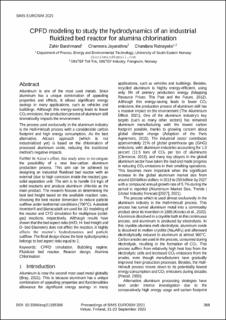| dc.contributor.author | Barahmand, Zahir | |
| dc.contributor.author | Jayarathna, Chameera | |
| dc.contributor.author | Ratnayake, Chandana | |
| dc.date.accessioned | 2022-11-23T13:20:48Z | |
| dc.date.available | 2022-11-23T13:20:48Z | |
| dc.date.created | 2022-11-22T17:49:03Z | |
| dc.date.issued | 2022 | |
| dc.identifier.citation | Barahmand, Z., Jayarathna, C., & Ratnayake, C. (2021, 21.-23. september). CPFD Modeling to study the Hydrodynamics of an Industrial Fluidized Bed Reactor for Alumina Chlorination. The First SIMS EUROSIM Conference on Modelling and Simulation, SIMS EUROSIM 2021, and 62nd International Conference of Scandinavian Simulation Society, SIMS 2021, Virtual Conference, Finland. | en_US |
| dc.identifier.issn | 1650-3686 | |
| dc.identifier.uri | https://hdl.handle.net/11250/3033680 | |
| dc.description.abstract | Aluminum is one of the most used metals. Since aluminum has a unique combination of appealing properties and effects, it allows significant energy savings in many applications, such as vehicles and buildings. Although this energy-saving leads to lower CO2 emissions, the production process of aluminum still dramatically impacts the environment. The process used exclusively in the aluminum industry is the Hall-Héroult process with a considerable carbon footprint and high energy consumption. As the best alternative, Alcoa's approach (which is not industrialized yet) is based on the chlorination of processed aluminum oxide, reducing the traditional method's negative impacts. Further to Alcoa’s effort, this study aims to investigate the possibility of a new low-carbon aluminum production process. This aim can be achieved by designing an industrial fluidized bed reactor with an external (due to high corrosion inside the reactor) gas-solid separation unit. The aim is to handle 0.6 kg/s of solid reactants and produce aluminum chloride as the main product. The research focuses on determining the best bed height based on the available reaction rates, choosing the best reactor dimension to reduce particle outflow under isothermal conditions (700°C). Autodesk Inventor® and Barracuda® are used for 3D modeling of the reactor and CFD simulation for multiphase (solid-gas) reactions, respectively. Although results have shown that the bed aspect ratio (H/D; H- bed Height and D- bed Diameter) does not affect the reaction, it highly affects the reactor’s hydrodynamics and particle outflow. The final design shows the best hydrodynamics belongs to bed aspect ratio equal to 2. | en_US |
| dc.language.iso | eng | en_US |
| dc.rights | Navngivelse 4.0 Internasjonal | * |
| dc.rights.uri | http://creativecommons.org/licenses/by/4.0/deed.no | * |
| dc.title | CPFD Modeling to study the Hydrodynamics of an Industrial Fluidized Bed Reactor for Alumina Chlorination | en_US |
| dc.type | Journal article | en_US |
| dc.type | Peer reviewed | en_US |
| dc.description.version | publishedVersion | en_US |
| dc.rights.holder | © 2022 Zahir Barahmand, Chameera Jayarathna, Chandana Ratnayake. | en_US |
| dc.source.pagenumber | 368-375 | en_US |
| dc.source.volume | 185 | en_US |
| dc.source.journal | Linköping Electronic Conference Proceedings | en_US |
| dc.identifier.doi | https://doi.org/10.3384/ecp21185368 | |
| dc.identifier.cristin | 2078649 | |
| cristin.ispublished | true | |
| cristin.fulltext | original | |
| cristin.qualitycode | 1 | |

